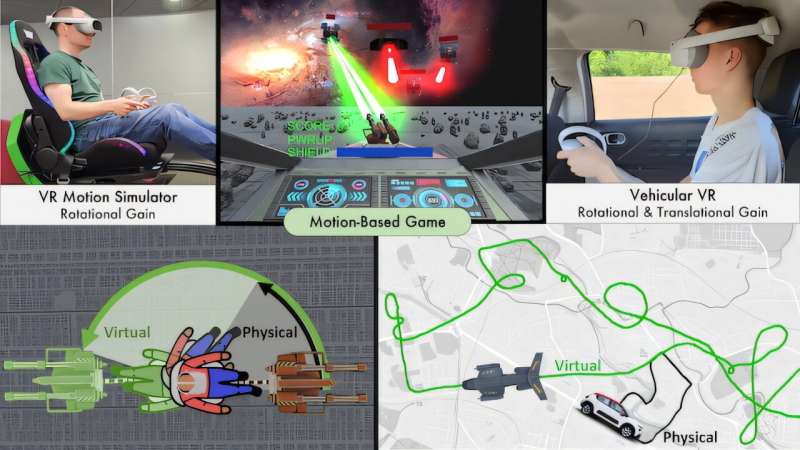Surprising new research has revealed that people’s perception of motion can be radically manipulated in passive virtual reality environments without making them feel unwell.
Researchers from the University of Glasgow led the study, which demonstrated for the first time that people using VR headsets in motorized simulator seats or while being driven in cars can be easily fooled into thinking they are moving or turning much more dramatically than they are in reality.
Small turns can be made to feel like 360-degree rotations and turns in one physical direction can be shown as turns in the opposite direction in VR without any negative effect on users’ comfort, the team found.
Recommendations from the study could help greatly expand the potential of VR to provide more immersive passive experiences, where users aren’t in direct control of their movements. It could open up new advances in video games, theme park rides, or driving and flight simulators.
The team’s research, which is set to be presented as a paper at the CHI 2025 conference in Japan later this month, set out to investigate how sensitive people are to differences between their perceived and actual motion when using VR headsets.
The three-part study examined users’ reactions to different tasks while interacting with VR environments. In the first, they sat in a motorized rotating chair and played a shooting game. The team rotated the chair at different speeds and angles between 15 and 90 degrees while displaying virtual turns that steadily increased the perceived degree of motion—a perceptual manipulation technique called “rotational gain.”

They found that they could amplify the rotational gain up to a turn four times greater in VR than in reality—making a 90-degree turn appear like 360 degrees, for example—before users noticed the mismatch between the real and the simulated. They also found that they could amp up the rotational gain up to 1,700%—meaning that a physical turn of just 10 degrees could be made to feel like 170 degrees in VR—without causing users any discomfort.
In the second study, the team repeated the setup but also introduced “opposed motion,” where the physical turn of the chair was not matched by the virtual turn. Instead, the VR turn went in the opposite direction.
During this part of the study, the team tested whether the participants could recognize their perception was being tricked both while they were playing the game and when they were simply sitting and trying to pay attention to their motion. They found that having a task to focus on made volunteers significantly less likely to notice their movements, and that very few participants were even aware of their opposed motion.
In the third study, participants took their VR headsets out onto the roads as passengers in a car as it drove around city streets. Once again, they were asked to play a shooting game, and the team added an additional alteration of wearers’ perception—”translational gain,” where the motion in their virtual headsets was up to 7.5 times faster than their real-world speed.
The team found that they were able to create “unbounded” experiences, where users’ perception of their actual route and speed was completely unmoored from their sense of movement through their virtual world. They also noted that when the virtual speed was increased, users were much less likely to be aware when they were turning in the real world.
Dr. Graham Wilson, of the University of Glasgow’s School of Computing Science, is one of the paper’s authors. He said, “What we’ve been able to show with this study is that, to a very surprising degree, you can heavily manipulate people’s perceptions of movement and speed in passive scenarios without causing any ill effects. In simulator chairs and in cars, people can easily be fooled into thinking they are moving faster, further, and even in the opposite direction while their real-world movements remain relatively sedate and confined.
“This could help address one of the main constraints of VR experiences, which is simply a lack of space. In the future, relatively inexpensive motorized chairs with limited ranges or movement could help home users experience much more immersive VR games and activities by freely manipulating their perceptions a great deal more than anyone had previously realized.
“In places like theme parks, where there is a bit more space but moving VR simulators are still confined to tracks or rails, there’s much more latitude to control how exciting those experiences can be without making people sick or too aware of how their senses are being tricked. And in cars or on public transport, passengers could engage with VR experiences that can take them entirely out of their surroundings to make trips more enjoyable.”
The paper builds on previous research from the team which showed that car passengers could enjoy games which moved at “ludicrous speed” without experiencing motion sickness.
Professor Stephen Brewster, a co-author of the paper, leads the ViAjeRo research project which is investigating the potential of VR and AR technologies to improve passenger journeys.
Professor Brewster said, “This is an exciting result, which suggests that passive VR experiences are much more open to manipulation than active ones, where previous research has shown that people are much more sensitive to having their perception of movement altered.
“The paper includes a series of recommendations for how our insights can be used to help create finely-tuned immersive experiences in the future. We hope our work will help designers of VR games, simulators, experiences and more drive forward advances in what is still a developing field.
“We’re also working on further research which will build on these studies, including exploring the effects of prolonged exposure to this kind of perceptual manipulation and how adding additional axes like roll and pitch might affect people’s awareness of movement.”
The team’s paper, titled “The Spin Doctor: Leveraging Insensitivity to Passive Rotational & Translational Gain For Unbounded Motion-Based VR Experiences,” will be presented at the CHI 2025 conference in Yokohama, Japan, on Monday 28th April.
Citation:
VR can take users for a sneaky spin without making them sick, research shows (2025, April 14)
retrieved 14 April 2025
from https://techxplore.com/news/2025-04-vr-users-sneaky-sick.html
This document is subject to copyright. Apart from any fair dealing for the purpose of private study or research, no
part may be reproduced without the written permission. The content is provided for information purposes only.

